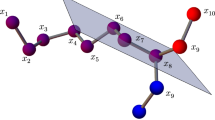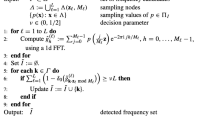Abstract
It is known that a multidimensional FFT with prime edge-length p and linear symmetries in its inputs, given by a matrix S, can be computed efficiently in terms of cyclic convolutions by determining a nonsingular matrix M that commutes with S and that minimizes the number of MS-orbits. To date the only known method for determining such an M is by exhaustion, which takes time O(p 6) in the two-dimensional case and time O(p 12) in the three-dimensional case. In this work we study methods for determining M directly. Our results include algorithms which, assuming the availability of primitive polynomials, compute M in time O(p) in the two-dimensional and, in a special three-dimensional case that is important for crystallographers. Furthermore, also assuming the availability of primitive polynomials of degree three, we give an O(p 3) time algorithm to compute the M-minimal three-dimensional case.
Access this chapter
Tax calculation will be finalised at checkout
Purchases are for personal use only
Preview
Unable to display preview. Download preview PDF.
Similar content being viewed by others
References
Auslander, L., Shenefelt, M.: Fourier Transforms that Respect Crystallographic Symmetries. IBM J. Res. and Dev. 31, 213–223 (1987)
Elspas, B.: The Theory of Autonomous Linear Sequential Networks. In: Kautz, W. (ed.) Linear Sequential Switching Circuits, pp. 21–61. Holden-Day Inc. (1965)
Horn, R.A., Johnson, C.R.: Matrix Analysis. Cambridge University Press, Cambridge (1999)
McCoy, N.H.: Rings and Ideals. The Carus Mathematical Monographs. The Mathematical Association of America (1956)
Lidl, R., Niederreiter, H.: Finite Fields, 2nd edn. Encyclopedia of Mathematics and its Applications, vol. 20. Cambridge University Press, Cambridge (1997)
Orozco, E., Bollman, D., Seguel, J., Moreno, O.: Organizing Crystallographic Data. Poster presentation. In: Ponce, P.R. (ed.) 1st Conference in Protein Structure, Function and Dynamics, February 7-9 (2003)
Seguel, J., Bollman, D., Orozco, E.: A New Prime Edge-Length Crystallographic FFT. In: Sloot, P.M.A., Tan, C.J.K., Dongarra, J., Hoekstra, A.G. (eds.) ICCS-ComputSci 2002. LNCS, vol. 2330, pp. 548–557. Springer, Heidelberg (2002)
Seguel, J.: Design and Implementation of a Parallel Prime Edge-Length Symmetric FFT. In: Kumar, V., Gavrilova, M.L., Tan, C.J.K., L’Ecuyer, P. (eds.) ICCSA 2003. LNCS, vol. 2667, pp. 1025–1034. Springer, Heidelberg (2003)
Seguel, J., Burbano, D.: A Scalable Crystallographic FFT. In: Dongarra, J., Laforenza, D., Orlando, S. (eds.) EuroPVM/MPI 2003. LNCS, vol. 2840, pp. 134–141. Springer, Heidelberg (2003)
Author information
Authors and Affiliations
Editor information
Editors and Affiliations
Rights and permissions
Copyright information
© 2004 Springer-Verlag Berlin Heidelberg
About this paper
Cite this paper
Orozco, E., Bollman, D. (2004). Optimizing Symmetric FFTs with Prime Edge-Length. In: Laganá, A., Gavrilova, M.L., Kumar, V., Mun, Y., Tan, C.J.K., Gervasi, O. (eds) Computational Science and Its Applications – ICCSA 2004. ICCSA 2004. Lecture Notes in Computer Science, vol 3045. Springer, Berlin, Heidelberg. https://doi.org/10.1007/978-3-540-24767-8_78
Download citation
DOI: https://doi.org/10.1007/978-3-540-24767-8_78
Publisher Name: Springer, Berlin, Heidelberg
Print ISBN: 978-3-540-22057-2
Online ISBN: 978-3-540-24767-8
eBook Packages: Springer Book Archive




